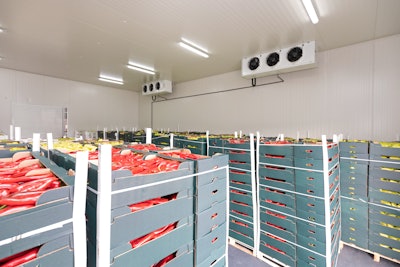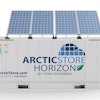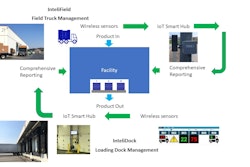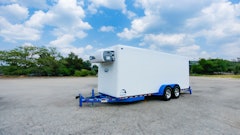
Environmental responsibility is a top priority in every industry, including food and beverage distribution. Today’s companies recognize they must take accountability toward this goal, and customers and stakeholders alike are holding them to higher sustainability standard. As a result, many food logistics companies make decisions with sustainability in mind and are considering new choices for their refrigeration equipment needs.
Legislation also affects how facilities use energy and which refrigerants they select. Recent and pending Department of Energy (DOE) regulations have changed energy efficiency minimums across the HVACR industry, including commercial refrigeration and cold storage.
The California Air Resources Board (CARB) is phasing out hydrofluorocarbons (HFCs). California Senate Bill 1383 requires the state to reduce HFC emissions to 40 percent below 2013 levels by 2030 and anything over a 50-pound charge must use refrigerant with a global warming potential (GWP) of 150 or lower. While this is currently a California standard, it will have impact for the industry in a broader way. Similar refrigerant limitations will certainly follow from a number of states over the next several years.
As companies comply with these new regulations, energy efficiency and refrigerant standards may be at odds with each other. For cold storage facilities to meet regulations and operate responsibly – both today and in the future – it’s important to use refrigerants that are low-GWP and energy-efficient, such as carbon dioxide (CO2).
CO2 has an ultralow GWP of 1 and facilities that use transcritical CO2 systems have a great opportunity to save energy. Here are five reasons why CO2 sets the standard for sustainable refrigerants in food and beverage logistics cold storage facility applications.
1. CO2 is a natural refrigerant. While a naturally occurring element in our atmosphere, CO2 is also a cost-effective refrigerant. It is available in a grade which lowers its moisture content allowing it to be an effective refrigerant alternative. This is one aspect which allows the total cost of ownership for a CO2 system to be quite enticing.
2. CO2 is energy efficient. Refrigerants have different energy demands and directly impact overall system efficiency, including those of refrigerated warehouses. This will impact a facility’s resource usage and overall utility costs. The latest transcritical CO2 technology continues to improve energy consumption. In a large cold storage facility, an energy-efficient transcritical CO2 system uses a parallel compressor system with multiple compressors on a common rack. They can be designed for use with multiple temperature zones within one system. These CO2 systems have a strong energy payback potential and facilities using them may qualify for significant energy-efficiency rebates.
Additionally, CO2 is a good source for heat, which can be used for other purposes. Reclaimed heat can be used to warm the floor or assist in heating water for process applications, applications that would otherwise consume additional energy. Today’s energy saving CO2 systems are another reason there is a favorable total cost of ownership compared to other refrigerants.
3. CO2 is not flammable. For some refrigerants, flammability rises as GWP decreases. That isn’t the case with CO2. CO2 has a GWP of 1 and is non-flammable. Refrigerant flammability may be a concern to some end users and this concern would be mitigated using CO2.
4. CO2 is not toxic. Another safety concern in cold storage warehouses is refrigerant toxicity. If toxic refrigerants leak, it can be dangerous for building occupants. If CO2 refrigerant leaks, the gas itself is not toxic for people who may come into contact with it. CO2 can displace oxygen if the space lacks proper ventilation specific to the properties of the gas. Proper ventilation systems should be considered for CO2 projects.
5. CO2 is future-proof. As regulations continue to evolve, some refrigerants could have interim compliance. Facilities using refrigerants that could be phased out in the future may have to continue to update their refrigerant – and possibly their equipment. CO2 refrigerant has a GWP of 1, which will not have future regulatory concerns. Installing a CO2 system makes it possible to stay ahead of upcoming requirements, maintain compliance and avoid expensive retrofits – today and tomorrow.
CO2 sets the standard for sustainable cold storage
CO2 transcritical booster systems are growing in popularity and are ideal for food logistics applications. These sustainable systems can help cold storage facilities improve their environmental impact and reliably meet energy efficiency and refrigerant regulatory requirements. There has been significant research, development and improvements of CO2 technology that makes it ideal for refrigerated warehouse operators to consider as an option in future projects.
Making the switch to a CO2 system is a good alternative, but it’s critical to work with a partner who invests the time in comprehensive contractor and end-user training. CO2 must be handled differently than other refrigerants and it is important to make sure there is a full understanding of what is needed for proper system design and safety considerations. Proper training and education leads to confidence and comfort for everyone involved.
With every successful installation, it’s becoming clear CO2 is positioned to be a leading refrigerant for food logistic facilities. With CO2 refrigerant, cold storage facilities can have it all – low-GWP to avoid future regulatory issues, energy-efficiency to lower ongoing energy cost, all leading to an overall lower total cost of ownership. All of this in one sustainable solution.



















